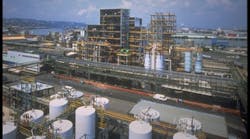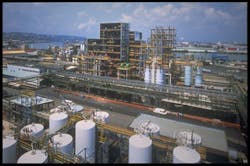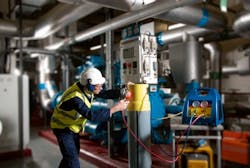The recent international agreement to phase out hydrofluorocarbons (HFCs) — “Montreal Protocol Addresses HFCs” — and the decision by U.S. Environmental Protection Agency (EPA) to ban hydrocarbon refrigerants from all but a few process refrigeration applications promise significant changes for industry. Opportunities and challenges abound for refrigerant manufacturers such as Chemours and Arkema, repackers like Linde, and equipment suppliers including Versatile Refrigeration and Danfoss.
For its part, Chemours, Wilmington, Del., welcomed the HFC amendment agreement to the Montreal Protocol as an opportunity to address the high global warming potential (GWP) of the gases. The company already has invested hundreds of millions of dollars in its Opteon product line for use in applications such as refrigeration, air conditioning, foam insulation and waste-heat recovery.
Its most recent commercializations include Opteon XP40 (R-449A) and Opteon XP10 (R-513A), which replace refrigerants banned by the EPA’s significant new approvals policy (SNAP) program.
Figure 1. Pierre-Bénite complex is shutting down its R134a plant and reorganizing production to focus on other fluorogases, fluoropolymers and derivatives. Source: Arkema.
Automakers rapidly are converting to HFO-1234yf (Opteon YF) for air conditioning systems. Chemours estimates that 50 million vehicles will be using it by the end of 2017; it expects this figure to rise to 140 million by the end of 2020. The company also predicts that up to 10,000 supermarket and commercial refrigeration systems worldwide will be using Opteon XP40 by the end of 2020.
To meet this growing demand, Chemours is investing $230 million at its Ingleside, Texas, site to create the world’s largest facility for making hydrofluoroolefins (HFOs). Due to be commissioned toward the end of 2018, the new facility will triple capacity of Opteon products.
Fluorine chemical specialist Arkema, Colombes, France, also welcomed the new agreement, pointing out that while HFCs have been important in the transition from chlorofluorocarbons (CFCs) and hydrochlorofluorocarbons (HCFCs), the future lies with HFOs because of their excellent performance characteristics and lower GWP.
Arkema has decided to shut down the R134a fluorogas plant at its Pierre-Bénite site in France (Figure 1). The gas is being phased out for use in automotive air conditioning systems, which is the company’s main market in Europe.
The shutdown is planned for the first quarter of 2017. At the same time, a major reorganization of production is ongoing at the site. This will result in a refocusing on the manufacture of other fluorogases, fluorinated blends and derivatives for the stationary air-conditioning, refrigeration and non-emissive-uses markets, as well as the manufacture of fluoropolymers and certain catalysts.
Repacker Response
Meanwhile, gas repackers such as BOC, Guildford, U.K., a subsidiary of the Linde Group, Munich, also are gearing up for the changing marketplace. The company offers a range of refrigerants including ammonia, carbon dioxide, ethane, ethylene, propane, isobutene and propylene — many as part of its proprietary CARE blends — as well as HFOs including Opteon YF, XP40 and XP44.
“BOC is not a manufacturer of refrigerants; we are a repacker. We do not develop and test new products. However, our refrigerant gas facility (RGF) based at Immingham, U.K., has the capability to blend bespoke mixes to suit customer requirements,” notes Matt Leong, product manager, special chemicals and refrigerants.
Figure 2. Technician safely retrieves refrigerant gases from a chiller pack. Source: Linde.
The company also has a focus on recovery services to enable the safe and legal disposal of refrigerants, together with reclamation and waste services (Figure 2).
The advantages of natural refrigerants, according to Leong, are lower gas cost, low GWP, good efficiency and the fact they work well with most common oils. Disadvantages include flammability, toxicity, high pressures, plus the special training and correct equipment needed to work with them. “Refrigeration plants that use not-in-kinds (NiKs) generally cost more to install because the systems specifications are much higher,” he adds.
Hydrocarbon refrigerants also boast lower gas cost, low GWP, work with most common oils, and provide better efficiency, Leong notes. Their disadvantages include the specialized training needed, the difficulty in retrofitting an existing system and a lack of availability of equipment rated for hazardous environments. “Engineers need special training and the right equipment to work with these products. Refrigeration plants that use hydrocarbons generally cost more to install, too,” he says.
“BOC’s challenge for the future will be managing the new generation HFO refrigerants, managing our bulk storage abilities at our RGF, knowing what new generation refrigerants to stock while making full use of our cylinder assets, along with customer requirements for recycling and banking product for future use,” he explains.
Potential Issues
Eric MacGregor, managing director, Versatile Refrigeration International Inc., Duncan, B.C., has concerns not only about the new rules but also about how they will be implemented and the training they will involve.
“The EPA’s decision, combined with the Montreal Protocol, essentially means that the world has decided to phase out HFCs. So the pressure is on to find a replacement. In my opinion, the main player has been banned: hydrocarbons have a proven track record and a well-developed market both in Europe and elsewhere. Their efficiency, lower charge weight, better oil miscibility and lower cost make them very acceptable,” he argues.
Meanwhile, the application of rules continues to vary within and between jurisdictions, he says, especially in the U.S., where it can differ from state-to-state, county-to-county, and even from city-to-city in terms of licensing. For example, Seattle’s licensing program for refrigeration engineers is very different from that in the rest of the state of Washington.
Less variation exists in Canada because a person must pass a national test before becoming a licensed contractor in any of the provinces.
In addition, the definition of acceptable use is still an issue for end-users, he stresses. The EPA regulates on the basis of end use, for example industrial refrigeration. However, various mechanical codes also apply, for example the Californian Mechanical Code, the Uniform Mechanical Code, International Mechanical Code, etc. “While these read fairly similarly, they are not identical,” he explains. “Although they overlap in many areas, you do end up with some sections in one being directly blocked by sections in another. So you either fall foul of a code, or of the EPA, with one saying ‘yes’ and the other saying ‘no’ in a particular situation.”
As an example of how this might occur, he cites the case of a company on an industrial complex that wishes to use a hydrocarbon refrigerant, for example R290 or R1270, along with a secondary glycol or brine loop. Most codes allow this, given compliance with relevant provisions for the system, ventilation and so on. However, he points out, hydrocarbons are banned by the EPA in the end-use category of cold storage and therefore may not be used. “In this case, you would have to use an HFC, which eventually will be phased out, or ammonia, which has its own concerns and special requirements under EPA rules.”
Then there is the issue of training and proper handling of refrigerant gases. “This is so very important because all of them have risk factors that we need to understand and be aware of,” he cautions.
For example, A1 refrigerants can present a fire hazard when mixed with oils, as they are in some systems. If there is a leak, the oil is spread as an aerosol and becomes an ignition hazard. Others refrigerants pose cardiac and oxygen-displacement effects.
Likewise, when brazing in new components or repairing a leak where HCFCs or CFCs are used, any remaining gas in an evacuated vessel can decompose under the high heat used and produce poisonous chlorine gas.
MacGregor also voices some doubts about how quickly HFCs will be phased out, noting that so much equipment currently is running them — R404a, R507 and R410, for example — and many end-users, contractors and distributors aren’t yet aware of the global agreement.
“The new regulations are all very fresh and recent and we need to see how they and the market move as we go forward. Of course, all this could change if there are big reorganizations made at the EPA by the new administration,” he concludes.
A Danish Perspective
“Denmark has always been ahead when it comes to adopting environmental regulations, even European ones. The big leap came in around 2000 when the country started to limit the use of HFCs. This caused a lot of panic at the time,” says Torben Funder-Kristensen, head of public and industrial affairs, Danfoss, Nordborg, Denmark.
So, the company started to look at alternatives to carbon-chain-based refrigerants and carbon dioxide became a big winner. “This happened because we can use it in large quantities and it is non-flammable and regarded as non-toxic in the right circumstances. To begin with, the R&D was difficult because the systems involved were expensive and experimental and there weren’t any alternatives. However, as it became cost competitive, we discovered other benefits with it, too, particularly in terms of heat recovery. It has very high efficiencies here and so the technologies to use it really started changing. It opened the path to another world. So today it is one of our focus areas and binds into our next energy agenda,” he emphasizes.
The idea here is to link Denmark’s district heating and cooling networks with exported waste heat from refrigeration. Supermarkets are an initial focus but the plan could easily be expanded to include industrial users of refrigeration as well.
“There are lots of opportunities in refrigeration, including carbon dioxide, butane, isobutene and propane. Ammonia is also in industrial use. We are seeing a lot of combined use of carbon dioxide and ammonia because in this context you only need a relatively low charge of ammonia. So you get to use carbon dioxide’s properties of very efficient heat transfer, low pumping cost, plus the need for only very small pipes,” he adds.
Like MacGregor, Funder-Kristensen has concerns about consistent standards for implementation of refrigerant systems and the added training needed for such systems.
“Hopefully we will move to more uniform standards globally and, for example, you see China and India adopting ISO and IEC standards now. During the Montreal Protocol talks, the Chinese delegation asked for much more harmonization of global standards, too. However, we must also consider the speed of developing new standards. This has always been at a slower pace than the fast changes in refrigerant demands — especially for the more flammable gases. This is a huge challenge but one I feel is being won because there is so much activity going on in the area. The issues are also less technical now; it’s rather to do with implementation,” he explains.
There also is a need to work on the application of existing standards, Funder-Kristensen believes. A lack of common practice in rolling out official safety standards and guidelines is leading to the local issues already highlighted in the U.S also occurring in Europe and in other parts of the world.
Education and training are the key here, he says, to make people competent in using the standards. “Even in Denmark, we see local fire safety people blocking certain applications because they see the word ‘flammable’ in the paperwork and assume it means high fire risk — even when we are talking mildly flammable and equipment that is widely used already in the same or similar applications.”
The bottom line is always the tradeoff between refrigeration system efficiency and cost, he stresses. “If you want a lower GWP across the applications, you have to really look at flammable refrigerants and this is actually where the battle is now. Technically it is no problem and we have drop-in solutions. The issue is having approval for them to be used in certain situations,” he explains. Once this is sorted out, Funder-Kristensen believes a whole new generation of smart energy concepts that will drive further technology developments will emerge.




